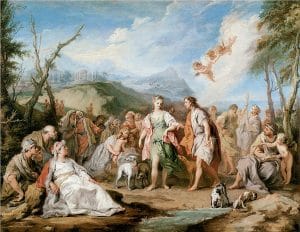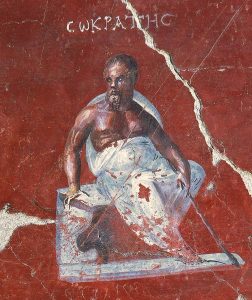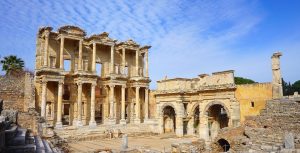Blog Titles
ToggleChildren and their lives in Ephesus
In the ancient city of Ephesus, the acceptance or rejection of the child at birth was a right given to the father during the Hellenistic period. The father may not want the child because of the child’s disability, the fact that there are many children in the family and economic difficulties. If the child was accepted by the father, it would be registered in the family register.
This was a very important situation. Because, when the child turned 18, he could benefit from all citizenship rights (selection, inheritance, etc.) by being included in the citizenship lists due to previous acceptance. Immediately after birth, the child was bathed in very cold water to see if he was healthy, and his life force was tested.
Childhood in Ephesus
Childhood in Ephesus, Hellenic period
If the born child was a boy, an olive branch was hung on the door of the house, and if it was a girl, a piece of woven fabric would be hung on the door of the house so that the gender of the child would be announced to the neighbors. Between the five/seven days following the birth of the child, a family holiday (AMPHIDROMIA) was organized and the child was accepted into the family.

At the reception, the father would take the child in his arms and walk it around the house fire three times. This meant that the child would be brought up by the family and would have citizenship rights in the future. After this feast, the father could no longer refuse the child in any way.
If the child was not accepted by the father, which was common in the early periods (7th-5th centuries BC), the child was left in the agora. The child was taken by someone in need, raised, and made a slave.
10 days after birth, the family would come together again and the child would be given a name. It was usually named after the grandfather or grandmother. On a naming day, those invited to the feast would bring gifts to the child, and the child would be given an amulet by his family with prayers and good wishes.
After the child was given a name, the mother and the house were considered to be free from all kinds of dirt, after which the woman would return to housework. Before bathing, the woman could not enter the sanctuary in any way.
Little children played games like building houses, driving cars, riding a horse-headed stick, sliding stones in water, spinning tops, and walking on long wooden sticks, which are not foreign to us today. Slightly older children and teenagers played games that required more dexterity and displayed their muscular strength. At the beginning of such games were ball, walnut, dice, and bone games. Leaving the walnut “Nueces Relinquere” symbolized the transition from childhood to youth.
Some of the walnut games for kids
a- Throwing the walnut through the hole. Sometimes a basket was used instead of a hole.
b- A triangle was drawn on the ground and separated by parallel lines. The child throws the walnut in his hand towards the triangle and the more parallels they pass, the more walnuts he is given. If the nut did not remain in the triangle after the shot, the player would lose the nut.
c- To make a fourth of three walnuts put together skillfully to stick. The player who succeeded in this would own three walnuts on the ground.
d- Walnuts were placed on the ground in a single row, and the player would drop a walnut towards the walnuts on the ground over a board that he held tilted to the ground. If the released walnut hit the walnut on the ground, that walnut would belong to the player and that player would continue to play. If the released nut did not hit one of the pecans on the ground, the player would lose the nut. Then he was asked to know the question of whether the walnuts in the other player’s hand were odd or even.
Ball games: The ball was sewn from brightly colored cloth and filled with hair. Large balls filled with feathers were called Paganica and Pagus. Hard and small balls filled with sand and used as catch balls were called Harpasta.
Some of the known ball games for kids
a- URANIA: To commemorate one of the players by throwing the ball into the air. It looked like a modern-day stop game. The player whose name was called and who could not catch the ball would be out of the game.
b- DATATIM LUDERE: It was when 2 people standing in a certain area skillfully throw the ball to each other and make the ball touch the opponent’s body. Whoever catches the ball by hand has a chance to throw the ball again.
c- EXPULSIM LUDERE / APORAXSIS: It was played as hitting the ball to the ground or a wall and hitting the spinning ball with your hand.
d- TRIGON: It was a game played by three people with a small handball Pila. Three people would stand at the corners of a triangle, throwing a small ball at each other. The person throwing the ball had to protect himself from the incoming balls, as the ball could be thrown at him at the same time.

e- EPISCUROS: It was a game played by many children at the same time. The children participating in the game were divided into 2 groups equally, aiming to eliminate their opponents from the game with the ball they threw to each other from the fields separated by a line in the middle. It was similar to today’s dodgeball.
f- HARPASTUM: It was a collective game. In this game, one person would throw the ball into the air, and the other players would try to prevent him from catching the ball again by nipping or pinching him.
The child’s first six years of care and education were the mother’s duty. Having a male child would increase the value of a woman. The mother would tell her child the outlines of Hellenic mythology and folk tales. The slave and foster mother, if any, would help the mother in this education.

When the child was seven years old, he was sent to the Gymnasium accompanied by a pedagogue (who protects and watches over the child). Classrooms in gymnasiums were small, 10-12 people were taken. The child would start his education there by learning to read and write and music.
During the Hellenistic period, the Ephesians learned the script from the Phoenicians in the 9-8 centuries BC in the town of Almina, where they went for trade. Writing was used for the first time in the Hellenic world to keep commercial records, and after the 8th century BC, it was used to record officer lists, civil service documents, and public meetings.
The first written monument is the inscription showing the list of winners in the Olympic games in 776 BC. Letter writing has spread and used throughout the Mediterranean basin since the 7th century BC.
In the first years, children were sent to the Gymnasium accompanied by Pedagogos. Perhaps one of the main purposes of this was to protect the child from homosexuality. Homosexuality was very common in the Hellenic world. It is not known how many years the gymnasiums continued. However, young people were leaving the gymnasium between the ages of 15 and 17.
After that, young people would receive 2 years of military training. After military service, the adolescent period was considered to be over, and the transition to manhood was celebrated by organizing a feast called APUTERIEN. On that day, the young man’s hair, which had grown until this date, was cut off and dedicated to the goddess Artemis.
Men would then have the right to attend and vote in popular assemblies. The education of girls was not given importance. They were expected to be more successful in knitting, weaving, and housework.
Childhood in Ephesus, Roman period
In the ancient city of Ephesus in the Roman period, a ceremony was held by the father of the child immediately after the birth. As soon as the child was born, it was laid on the ground and lifted from the soil by the father. This meant the acceptance of the child into the family. In some cases, for example, if the child is disabled, the father could reject his child. In this case, the child was left on the street or sold.
However, abortion was allowed. The mother could have aborted her unwanted child before she even gave birth. During the reign of Emperor Marcus Aurelius (161-180 AD) and Severus Alexander (222-235 AD), leaving a child on the street was considered murder and prohibited. In the time of Constantine the Great (306-337 AD) due to poverty, sometimes children were legally sold at birth. In 374 A.D., the abandonment or murder of a child was prohibited with the death penalty.
If the child was accepted into the family, the father would hang a wreath on the door of the house and an amulet around the child’s neck so that the gods would protect him from all kinds of evil. Name day was held nine days after the birth of the boy and eight days after the birth of the girl. On that day, the child was bathed in a religious ceremony and given the first name Praenomen. While this ceremony was previously performed for boys, A.D. II. Since the 19th century, the state has made it compulsory for girls.
Until the end of adolescence, the child was called by this first name. In some wealthy families, the care of the child was left to a foster mother in the early years of childhood under the supervision of her mother. Children started primary school at the age of seven Ludi Literarii. Education in this school continued until the child was 12 years old. Education in primary school was carried out by Pedagogos.

Boys and girls went to primary school together. For this reason, reading and writing were learned by large masses in the Roman period. In primary school, where daily education was limited to six hours, children were taught to read, write and calculate. Reading and writing started with learning the letters carved on a wooden board.
The student would go over the letters with a pointed stick called Situlus and learn the letters one by one and then the word.

Poetry, history of literature, units of measurement, music, philosophy, logic, physics astronomy, mythology, Hellenic language and grammar, Hellenic literature, and mathematics were taught in gymnasiums.
Lectures on Hellenic grammar and literature were deemed necessary for developments in politics and law. Hellenic orators were taken as an example, bilingual oratory lessons were given, and written and oral exercises were made. Calculation lessons were held on a wooden or metal sign called Abacus. They had signs called Calculi for simple calculations.
Gymnasion would end at age 17. At this age, the amulets around the neck of the young person were removed from the single-breasted toga (Toga Praetexta) that he had worn until that day, the victims were sacrificed, and the young man was dressed in a white-colored male toga (Toga Virilis) without any embroidery.
This event symbolized the youth’s transition from puberty to manhood. Although for jurists the age of puberty was set at 14 for boys and 12 for girls, in practice a boy was not considered a teenager without wearing a toga virilis. On the other hand, the girls’ coming out of childhood was with the marriage ceremony. Young men could join all kinds of committees from the age of 17.
As long as their fathers were alive, the young had to bring their earnings to their father’s home. Fathers’ dominance over sons was lifted if the father died or the father lost his civil rights. The father’s dominance over the son would also come to an end in cases such as the father’s exile, the father’s captivity in the war, or the son’s appointment to guard the fire in honor of Vesta, the goddess of the family hearth.





